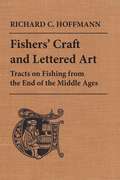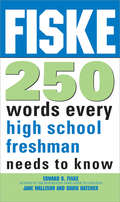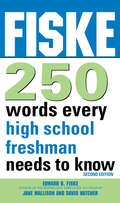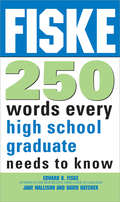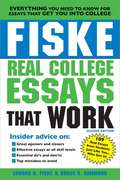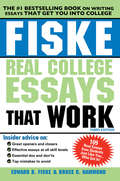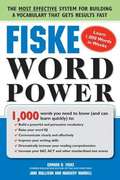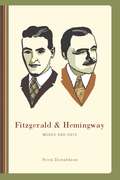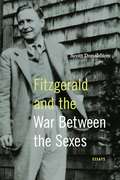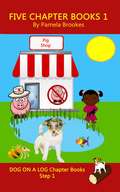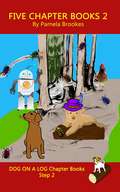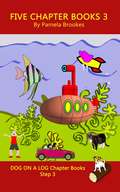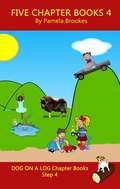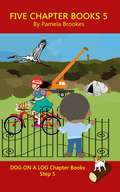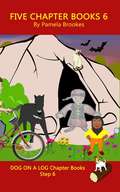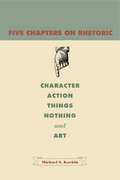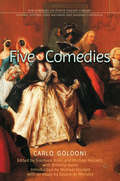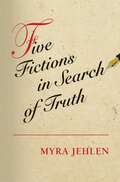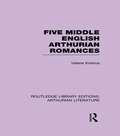- Table View
- List View
Fishers' Craft and Lettered Art: Tracts on Fishing from the End of the Middle Ages (The Royal Society of Canada Special Publications #12)
by Richard C. HoffmannFishers' Craft and Lettered Art provides editions, English translations, and analysis from social, cultural, and environmental perspectives of the three oldest European extended tracts on fishing. Richard Hoffmann discusses the history of fishing in popular culture and outlines the economic and ecologic considerations needed to examine and understand the fishing manuals. Hoffmann further explores how continental fishing traditions were conveyed from oral craft practice into printed culture, and proposes that these manuals demonstrate a lively and complex interaction between written texts and popular culture. The tracts are presented in their original languages - Spanish and German - with facing page translations. Close attention is paid to original setting, functions, and possible range of readings, with detailed explanatory notes to help modern fishers and historians.Fishers' Craft and Lettered Art is a fascinating look at one vital aspect of everyday life at the end of the Middle Ages.
Fiske 250 Words Every High School Freshman Needs to Know
by Jane Mallison Edward B. Fiske David HatcherStarting off with a powerful vocabulary is the best way to prepare for a successful, stress-free time in high school. High school opens a world of new ideas and experiences-along with more challenging and sophisticated concepts. Knowing these 250 words will give students the gift of a head start that will last for years to come. Every year, thousands of families trust Edward Fiske, author of the #1 bestselling Fiske Guide to Colleges and the former education editor of the New York Times , as their guide for honest advice on creating the best educational experience possible-because he knows and listens to students. Together with vocabulary experts Jane Mallison and David Hatcher, Fiske 250 Words Every High School Freshman Needs to Know gives students the most important words they'll encounter in high school, across a wide range of subjects and skill levels. This short, powerful tool will allow any student to expand his vocabulary, sharpen his writing skills, and be prepared to make the most of his high school years!
Fiske 250 Words Every High School Freshman Needs to Know (2nd edition)
by Edward FiskeHere are the 250 most important words students need to know to be successful in high school and beyond, from the former education editor of the New York Times and a leading educational authority. Each entry contains a complete definition, word origin, and example sentences, making it both the perfect gift for eighth grade graduation and an effective tool for expanding a student's vocabulary, preparing them for standardized tests, and increasing their writing skills. This is the perfect book for giving students who are entering high school a clear advantage before they begin.
Fiske 250 Words Every High School Graduate Needs to Know
by Jane Mallison Edward B. Fiske David HatcherLearn the words you need to succeed in college and beyond!With a powerful vocabulary on your side, a world of possibilities opens up. It is a gift of confidence and knowledge for college, your career, and beyond. Knowing these 250 words will give you the edge you need to succeed in anything you set your mind to do. Every year, thousands of families trust Edward Fiske, author of the #1 bestselling Fiske Guide to Colleges and the former education editor of the New York Times , as their guide for honest advice on creating the best educational experience possible-because he knows and listens to students. Together with vocabulary experts Jane Mallison and David Hatcher, Fiske 250 Words Every High School Graduate Needs to Know gives you the most important words you'll need to know to build your success across a wide range of subjects and skill levels. This short, powerful tool will expand your vocabulary, sharpen your writing skills, make you more persuasive, and prepare you for every success you want to achieve!
Fiske 250 Words Every High School Graduate Needs to Know 2E
by Jane Mallison Edward B. Fiske Dave HatcherHere are the 250 most important words students need to know to be successful in college and beyond, from the former education editor of the New York Times and a leading authority on college admissions. Each entry contains information on the word origin, a complete definition, and example sentences, making it both the perfect gift for high school graduation and an effective tool for expanding a student's vocabulary, increasing word comprehension, and honing their writing skills. This is the perfect book for giving young adults entering college or starting a career a clear advantage before they begin.
Fiske Real College Essays That Work
by Edward B. Fiske Bruce G. HammondThe #1 book on college admissions essays, completely updated and revised From the most trusted name in college admissions, Fiske Real College Essays That Work is the first application essay book designed for those who need it most: bright students who aren't natural writers. College experts Edward Fiske and Bruce Hammond offer readers the best, most student-tailored advice on how to choose their topic and write their essay. Students can learn by example with more than 100 real sample essays, chosen from all degrees of writing proficiency, including 20 brand-new essays from students who got into the most up-and-coming, in-demand schools. Examples are also given to show how an essay is edited from initial to final draft. Fiske and Hammond give students an all-inclusive guide to writing an application essay that will open the door to the college of their dreams.
Fiske Real College Essays That Work
by Edward Fiske Bruce HammondTop College Essays That Show You What Works1. Take the stress out of writing your essays!Every fall, thousands of aspiring students just like you spend hours staring at a computer screen, searching for a clever opening line or life-changing experience. It doesn't have to be that hard--we'll help you push past writer's block and find a topic that works for you!2. Let your personality shine through!A good essay does not need to be a literary masterpiece or a scholarly treatise worthy of James Joyce. The best essays come from high school students just being themselves. We'll teach you how to showcase yourself--and all the depth, with, charm, and quirkiness you bring to your daily life.3. Submit an essay that will get you in!College admissions experts Edward B. Fiske and Bruce G. Hammond give you all the advice you need for an essay that will open the door to the college of your choice. You'll find effective examples from real applicants--of all skill levels--and learn how to successfully bring your essay from initial draft to final submission.Real essays on these topics and more: Athletics The Arts Racial and Cultural Differences Humor Family Personal Growth Travel
Fiske Real College Essays that Work 3E
by Edward B. Fiske Bruce G. HammondFrom the most trusted name in college admission resources comes the first application–essay book designed for those who need it most–bright students who aren't natural writers. By providing more than 100 real sample essays, college experts Edward Fiske and Bruce Hammond give students an all–inclusive guide to writing an application essay that will open the door to the college of their choice. Includes samples written with all degrees of proficiency and describes how to edit an essay, from initial draft to final submission.
Fiske Word Power
by Jane Mallison Edward B. Fiske Margery MandellThe Exclusive System to Learn-Not Just Memorize-Essential Words A powerful vocabulary opens a world of opportunity. Building your word power will help you write more effectively, communicate clearly, score higher on standardized tests like the SAT, ACT, or GRE, and be more confident and persuasive in everything you do. But in order to truly increase your vocabulary, you need a system that works. With most guides, you end up only memorizing the new words for a short time, often not even long enough to use them in tests. Fiske WordPower is different. Using the exclusive Fiske system, you will not just memorize words, but truly learn their meanings and how to use them correctly. This knowledge will stay with you longer and be easier to recall-and it doesn't take any longer than less-effective memorization. How does it work? This book uses a simple three-part system: 1. Patterns: Words aren't arranged randomly or alphabetically, but in similar groups that make words easier to remember over time. 2. Deeper Meanings, More Examples: Full explanations-not just brief definitions-of what the words mean, plus multiple examples of the words in sentences. 3. Quick Quizzes: Frequent short quizzes help you test how much you've learned, while helping your brain internalize their meanings. Fiske WordPower is the most effective system for building a vocabulary that gets you clear and successful results.
Fitzgerald and Hemingway: Works and Days
by Scott DonaldsonF. Scott Fitzgerald and Ernest Hemingway might have been contemporaries, but our understanding of their work often rests on simple differences. Hemingway wrestled with war, fraternity, and the violence of nature. Fitzgerald satirized money and class and the never-ending pursuit of a material tomorrow. Through the provocative arguments of Scott Donaldson, however, the affinities between these two authors become brilliantly clear. The result is a reorientation of how we read twentieth-century American literature. Known for his penetrating studies of Fitzgerald and Hemingway, Donaldson traces the creative genius of these authors and the surprising overlaps among their works. Fitzgerald and Hemingway both wrote fiction out of their experiences rather than about them. Therefore Donaldson pursues both biography and criticism in these essays, with a deep commitment to close reading. He traces the influence of celebrity culture on the legacies of both writers, matches an analysis of Hemingway's Spanish Civil War writings to a treatment of Fitzgerald's left-leaning tendencies, and contrasts the averted gaze in Hemingway's fiction with the role of possessions in The Great Gatsby. He devotes several essays to four novels, Gatsby, Tender Is the Night, The Sun Also Rises, and A Farewell to Arms, and others to lesser-known short stories. Based on years of research in the Fitzgerald and Hemingway archives and brimming with Donaldson's trademark wit and insight, this irresistible anthology moves the study of American literature in bold new directions.
Fitzgerald and Hemingway: Works and Days
by Scott DonaldsonF. Scott Fitzgerald and Ernest Hemingway might have been contemporaries, but our understanding of their work often rests on simple differences. Hemingway wrestled with war, fraternity, and the violence of nature. Fitzgerald satirized money and class and the never-ending pursuit of a material tomorrow. Through the provocative arguments of Scott Donaldson, however, the affinities between these two authors become brilliantly clear. The result is a reorientation of how we read twentieth-century American literature.Known for his penetrating studies of Fitzgerald and Hemingway, Donaldson traces the creative genius of these authors and the surprising overlaps among their works. Fitzgerald and Hemingway both wrote fiction out of their experiences rather than about them. Therefore Donaldson pursues both biography and criticism in these essays, with a deep commitment to close reading. He traces the influence of celebrity culture on the legacies of both writers, matches an analysis of Hemingway's Spanish Civil War writings to a treatment of Fitzgerald's left-leaning tendencies, and contrasts the averted gaze in Hemingway's fiction with the role of possessions in The Great Gatsby. He devotes several essays to four novels, Gatsby, Tender Is the Night, The Sun Also Rises, and A Farewell to Arms, and others to lesser-known short stories. Based on years of research in the Fitzgerald and Hemingway archives and brimming with Donaldson's trademark wit and insight, this irresistible anthology moves the study of American literature in bold new directions.
Fitzgerald and the War Between the Sexes: Essays
by Scott DonaldsonWritten by the preeminent Fitzgerald biographer and literary critic Scott Donaldson, this book presents a fresh, insightful exploration of the war between the sexes in F. Scott Fitzgerald’s fictional and autobiographical writings.The volume opens with a close reading of Tender Is the Night, in which Donaldson argues that the key theme of the novel is warfare—the struggle between the sexes for dominance in a marriage or relationship. Other essays expand on this theme, examining Fitzgerald’s assessment of love and the American dream in The Great Gatsby, Zelda Fitzgerald’s alleged affair with the French aviator Edouard Jozan, the writer’s relationship with his fellow author Dorothy Parker, and Fitzgerald’s autobiographical writings, in which he recounts his fast, extravagant life during the Jazz Age.Engagingly written and based on a deep understanding of Fitzgerald’s life and career, Fitzgerald and the War Between the Sexes will inform and influence fans and students of Fitzgerald’s work for many years to come.
Five Chapter Books 1: Decodable Books for Phonics Readers and Dyslexia/Dyslexic Learners (DOG ON A LOG Chapter Book Collection #Volume 1)
by Pamela BrookesDecodable Chapter Books for Phonics Readers and folks with a Dyslexic Learning Style <P><P>This collection is the five books in Step 1 of the DOG ON A LOG Chapter book series. <P><P>The books are: The Dog On The Log</br> The Pig Hat</br> Chad The Cat</br> Zip The Bug</br> The Fish and The Pig <P><P>Individual books can also be purchased separately. <P><P>Sight Words:</br> a, are, be, does, go, goes, has, he, her, his, into, is, like, my, of, OK, says, see, she, the, they, to, want, you <P><P>Each book has about 260 to 470 total words <P><P>These are Step 1 Chapter books. <P><P>The DOG ON A LOG Books series are for phonics readers and folks with a dyslexic learning style. The words used reflect the inclusion of 1 to 3 new phonics rules in each step. There are five books at each step. <P><P>The chapter books are written in a chapter format with one picture in most chapters. They are longer, have more detail, and sometimes offer more complexity than the Let’s GO! Books. They’re great for practicing known and new phonics rules. They’re also just fun reading. <P><P>DOG ON A LOG Let’s GO! Books are shorter versions of DOG ON A LOG Chapter books. Let’s GO! books tell the same stories with about 8 pictures and only a few sentences per page. They’re perfect as an introduction to the new phonics rules or simply for fun reading for younger kids. <P><P>DOG ON A LOG Phonics Progression <P><P>Step 1: Consonants, primary sounds Short vowels Digraphs: ch, sh, th, wh, ck 2 and 3 sound words Possessive ‘s <P><P>Step 2: Bonus letters (f, l, s, z after short vowel) “all” –s suffix <P><P>Step 3: ang, ing, ong, ung, ank, ink, onk, unk <P><P>Step 4: Consonant Blends to make 4 sound words 3 and 4 sound words ending in –lk, -sk <P><P>Step 5: Digraph blends –nch to make 3 and 4 sound words Silent e, including "-ke" <P><P>Step 6: ild, old, olt, ind, ost <P><P>Step 7: 5 sounds in a closed syllable word plus suffix -s (crunch, slumps) 3 letter blends and up to 6 sounds in a closed syllable word (script, spring) <P><P>Step 8: Two syllable words with 2 closed syllables, not blends (sunset, chicken, unfit) <P><P>WATCH FOR MORE STEPS AND BOOKS COMING SOON <P><P>For information on upcoming books see dogonalogbooks.com or visit our Facebook page.
Five Chapter Books 2: Decodable Books for Phonics Readers and Dyslexia/Dyslexic Learners (DOG ON A LOG Chapter Book Collections #Volume 2)
by Pamela BrookesDecodable Chapter Books for Phonics Readers and folks with a Dyslexic Learning Style. <P><P>This collection is the five books in Step 2 of the DOG ON A LOG Chapter book series. <P><P>The books are: <P><P>Mud On The Path</br> The Red Hen</br> The Hat And Bug Shop</br> Babs The ‘Bot</br> The Cub <P><P>Individual books can also be purchased separately. <P><P>Sight Words: </br> a, are, be, could, do, does, eggs, for, from, go, goes, has, have, he, her, here, his, I, into, is, like, likes, me, my, nest, of, OK, onto, or, puts, said, say, says, see, sees, she, should, the, they, to, want, wants, was, we, what, when, would, you, your <P><P>Each book has about 550 to 1,000 total words <P><P>These are Step 2 Chapter books. <P><P>The DOG ON A LOG Books series are for phonics readers and folks with a dyslexic learning style. The words used reflect the inclusion of 1 to 3 new phonics rules in each step. There are five books at each step. <P><P>The chapter books are written in a chapter format with one picture in most chapters. They are longer, have more detail, and sometimes offer more complexity than the Let’s GO! Books. They’re great for practicing known and new phonics rules. They’re also just fun reading. <P><P>DOG ON A LOG Let’s GO! Books are shorter versions of DOG ON A LOG Chapter books. Let’s GO! books tell the same stories with about 8 pictures and only a few sentences per page. They’re perfect as an introduction to the new phonics rules or simply for fun reading for younger kids. <P><P>DOG ON A LOG Phonics Progression <P><P>Step 1: Consonants, primary sounds Short vowels Digraphs: ch, sh, th, wh, ck 2 and 3 sound words Possessive ‘s <P><P>Step 2: Bonus letters (f, l, s, z after short vowel) “all” –s suffix <P><P>Step 3: ang, ing, ong, ung, ank, ink, onk, unk <P><P>Step 4: Consonant Blends to make 4 sound words 3 and 4 sound words ending in –lk, -sk <P><P>Step 5: Digraph blends –nch to make 3 and 4 sound words Silent e, including "-ke" <P><P>Step 6: ild, old, olt, ind, ost <P><P>Step 7: 5 sounds in a closed syllable word plus suffix -s (crunch, slumps) 3 letter blends and up to 6 sounds in a closed syllable word (script, spring) <P><P>Step 8: Two syllable words with 2 closed syllables, not blends (sunset, chicken, unfit) <P><P>WATCH FOR MORE STEPS AND BOOKS COMING SOON <P><P>For information on upcoming books see dogonalogbooks.com or visit our Facebook page.
Five Chapter Books 3: Decodable Books for Phonics Readers and Dyslexia/Dyslexic Learners (DOG ON A LOG Book Collections #Volume 3)
by Pamela BrookesDecodable Chapter Books for Phonics Readers and folks with a Dyslexic Learning Style <P><P>This collection is the five books in Step 3 of the DOG ON A LOG Chapter book series. <P><P>The books are: <P><P>Mr. Bing Has Hen Dots</br> The Junk Lot Cat</br> Bonk Punk Hot Rod</br> The Ship With Wings</br> The Sub In The Fish Tank <P><P>Individual books can also be purchased separately. <P><P>Sight Words: </br> a, are, as, be, could, do, does, for, from, go, goes, has, have, he, her, here, his, I, into, is, like, likes, me, Mr., Mrs., my, no, of, OK, or, put, puts, said, say, says, see, sees, she, should, the, their, there, they, to, want, wants, was, we, what, where, would, you, your <P><P>Each book has about 960 to 1,170 total words <P><P>These are Step 3 Chapter books. <P><P>The DOG ON A LOG Books series are for phonics readers and folks with a dyslexic learning style. The words used reflect the inclusion of 1 to 3 new phonics rules in each step. There are five books at each step. <P><P>The chapter books are written in a chapter format with one picture in most chapters. They are longer, have more detail, and sometimes offer more complexity than the Let’s GO! Books. They’re great for practicing known and new phonics rules. They’re also just fun reading. <P><P>DOG ON A LOG Let’s GO! Books are shorter versions of DOG ON A LOG Chapter books. Let’s GO! books tell the same stories with about 8 pictures and only a few sentences per page. They’re perfect as an introduction to the new phonics rules or simply for fun reading for younger kids. <P><P>DOG ON A LOG Phonics Progression <P><P>Step 1: Consonants, primary sounds Short vowels Digraphs: ch, sh, th, wh, ck 2 and 3 sound words Possessive ‘s <P><P>Step 2: Bonus letters (f, l, s, z after short vowel) “all” –s suffix <P><P>Step 3: ang, ing, ong, ung, ank, ink, onk, unk <P><P>Step 4: Consonant Blends to make 4 sound words 3 and 4 sound words ending in –lk, -sk <P><P>Step 5: Digraph blends –nch to make 3 and 4 sound words Silent e, including "-ke" <P><P>Step 6: ild, old, olt, ind, ost <P><P>Step 7: 5 sounds in a closed syllable word plus suffix -s (crunch, slumps) 3 letter blends and up to 6 sounds in a closed syllable word (script, spring) <P><P>Step 8: Two syllable words with 2 closed syllables, not blends (sunset, chicken, unfit) <P><P>WATCH FOR MORE STEPS AND BOOKS COMING SOON <P><P>For information on upcoming books see dogonalogbooks.com or visit our Facebook page.
Five Chapter Books 4: Decodable Books for Phonics Readers and Dyslexia/Dyslexic Learners (DOG ON A LOG Book Collections #Volume 4)
by Pamela Brookes<P><P>Decodable Chapter Books for Phonics Readers and folks with a Dyslexic Learning Style. <P><P>This collection is the five books in Step 4 of the DOG ON A LOG Chapter book series. <P><P>The books are: <P><P>The Push Truck</br> The Sand Hill</br> Lil Tilt And Mr. Ling</br> Musk Ox In The Tub</br> Trip To The Pond <P><P>Individual books can also be purchased separately. <P><P>Sight Words: </br> a, are, as, be, could, do, does, for, from, go, goes, has, have, he, her, here, his, I, into, is, like, likes, me, Mr., my, of, OK, or, push puts, said, saw. say, says, see, sees, she, should, the, there, they, to, want, wants, was, we, what, where, would, you, your <P><P>Each book has about 700 to 1,130 total words <P><P>These are Step 4 Chapter books. <P><P>The DOG ON A LOG Books series are for phonics readers and folks with a dyslexic learning style. The words used reflect the inclusion of 1 to 3 new phonics rules in each step. There are five books at each step. <P><P>The chapter books are written in a chapter format with one picture in most chapters. They are longer, have more detail, and sometimes offer more complexity than the Let’s GO! Books. They’re great for practicing known and new phonics rules. They’re also just fun reading. <P><P>DOG ON A LOG Let’s GO! Books are shorter versions of DOG ON A LOG Chapter books. Let’s GO! books tell the same stories with about 8 pictures and only a few sentences per page. They’re perfect as an introduction to the new phonics rules or simply for fun reading for younger kids. <P><P>DOG ON A LOG Phonics Progression <P><P>Step 1: Consonants, primary sounds Short vowels Digraphs: ch, sh, th, wh, ck 2 and 3 sound words Possessive ‘s <P><P>Step 2: Bonus letters (f, l, s, z after short vowel) “all” –s suffix <P><P>Step 3: ang, ing, ong, ung, ank, ink, onk, unk <P><P>Step 4: Consonant Blends to make 4 sound words 3 and 4 sound words ending in –lk, -sk <P><P>Step 5: Digraph blends –nch to make 3 and 4 sound words Silent e, including "-ke" <P><P>Step 6: ild, old, olt, ind, ost <P><P>Step 7: 5 sounds in a closed syllable word plus suffix -s (crunch, slumps) 3 letter blends and up to 6 sounds in a closed syllable word (script, spring) <P><P>Step 8: Two syllable words with 2 closed syllables, not blends (sunset, chicken, unfit) <P><P>WATCH FOR MORE STEPS AND BOOKS COMING SOON <P><P>For information on upcoming books see dogonalogbooks.com or visit our Facebook page.
Five Chapter Books 5: Decodable Books for Phonics Readers and Dyslexia/Dyslexic Learners (DOG ON A LOG Chapter Book Collections #Volume 5)
by Pamela BrookesDecodable Chapter Books for Phonics Readers and folks with a Dyslexic Learning Style. <P><P>This collection is the five books in Step 5 of the DOG ON A LOG Chapter book series. <P><P>The books are: <P><P>Bake A Cake</br> The Crane At The Cave</br> Ride A Bike</br> Crane Or Crane?</br> The Swing Gate <P><P>Individual books can also be purchased separately. <P><P>Sight Words: </br> a, are, as, be, come, comes, could, do, does, egg, eggs, for, from, go, goes, has, have, he, her, here, his, I, into, is, me, my, of, OK, or, pull, pulls, put, puts, said, say, says, see, sees, she, should, talk, the, their, there, they, to, walk, walks, want, wants, was, we, what, where, would, you, your <P><P>Each book has about 1,000 to 1,190 total words <P><P>These are Step 5 Chapter books. <P><P>The DOG ON A LOG Books series are for phonics readers and folks with a dyslexic learning style. The words used reflect the inclusion of 1 to 3 new phonics rules in each step. There are five books at each step. <P><P>The chapter books are written in a chapter format with one picture in most chapters. They are longer, have more detail, and sometimes offer more complexity than the Let’s GO! Books. They’re great for practicing known and new phonics rules. They’re also just fun reading. <P><P>DOG ON A LOG Let’s GO! Books are shorter versions of DOG ON A LOG Chapter books. Let’s GO! books tell the same stories with about 8 pictures and only a few sentences per page. They’re perfect as an introduction to the new phonics rules or simply for fun reading for younger kids. <P><P>DOG ON A LOG Phonics Progression <P><P>Step 1: Consonants, primary sounds Short vowels Digraphs: ch, sh, th, wh, ck 2 and 3 sound words Possessive ‘s <P><P>Step 2: Bonus letters (f, l, s, z after short vowel) “all” –s suffix <P><P>Step 3: ang, ing, ong, ung, ank, ink, onk, unk <P><P>Step 4: Consonant Blends to make 4 sound words 3 and 4 sound words ending in –lk, -sk <P><P>Step 5: Digraph blends –nch to make 3 and 4 sound words Silent e, including "-ke" <P><P>Step 6: ild, old, olt, ind, ost <P><P>Step 7: 5 sounds in a closed syllable word plus suffix -s (crunch, slumps) 3 letter blends and up to 6 sounds in a closed syllable word (script, spring) <P><P>Step 8: Two syllable words with 2 closed syllables, not blends (sunset, chicken, unfit) <P><P>WATCH FOR MORE STEPS AND BOOKS COMING SOON <P><P>For information on upcoming books see dogonalogbooks.com or visit our Facebook page.
Five Chapter Books 6: Decodable Books for Phonics Readers and Dyslexia/Dyslexic Learners (DOG ON A LOG Chapter Books #Volume 6)
by Pamela BrookesDecodable Chapter Books for Phonics Readers and folks with a Dyslexic Learning Style. <P><P>This collection is the five books in Step 6 of the DOG ON A LOG Chapter book series. <P><P>The books are: <P><P>The Colt </br> The Gold Bolt </br> Hide In The Blinds </br> The Stone Child </br> Tolt The Kind Cat <P><P>Sight Words: </br> a, are, as, be, come, comes, could, do, does, for, from, go, goes, has, have, he, her, here, his, I, into, is, me, Ms., my, no, of, OK, onto, or, pull, pulls, push, put, puts, said, say, says, see, sees, she, should, so, some, talk, talks, the, their, there, they, to, walk, walks, want, wants, was, we, what, where, would, you, your, yours <P><P>Each book has about 1,390 to 2,000 total words <P><P>These are Step 6 Chapter books. <P><P>The DOG ON A LOG Books series are for phonics readers and folks with a dyslexic learning style. The words used reflect the inclusion of 1 to 3 new phonics rules in each step. There are five books at each step. <P><P>The chapter books are written in a chapter format with one picture in most chapters. They are longer, have more detail, and sometimes offer more complexity than the Let’s GO! Books. They’re great for practicing known and new phonics rules. They’re also just fun reading. <P><P>DOG ON A LOG Let’s GO! Books are shorter versions of DOG ON A LOG Chapter books. Let’s GO! books tell the same stories with about 8 pictures and only a few sentences per page. They’re perfect as an introduction to the new phonics rules or simply for fun reading for younger kids. <P><P>DOG ON A LOG Phonics Progression <P><P>Step 1: Consonants, primary sounds Short vowels Digraphs: ch, sh, th, wh, ck 2 and 3 sound words Possessive ‘s <P><P>Step 2: Bonus letters (f, l, s, z after short vowel) “all” –s suffix <P><P>Step 3: ang, ing, ong, ung, ank, ink, onk, unk <P><P>Step 4: Consonant Blends to make 4 sound words 3 and 4 sound words ending in –lk, -sk <P><P>Step 5: Digraph blends –nch to make 3 and 4 sound words Silent e, including "-ke" <P><P>Step 6: ild, old, olt, ind, ost <P><P>Step 7: 5 sounds in a closed syllable word plus suffix -s (crunch, slumps) 3 letter blends and up to 6 sounds in a closed syllable word (script, spring) <P><P>Step 8: Two syllable words with 2 closed syllables, not blends (sunset, chicken, unfit) <P><P>WATCH FOR MORE STEPS AND BOOKS COMING SOON <P><P>For information on upcoming books see dogonalogbooks.com or visit our Facebook page.
Five Chapters on Rhetoric: Character, Action, Things, Nothing, and Art
by Michael S. KochinMichael Kochin’s radical exploration of rhetoric is built around five fundamental concepts that illuminate how rhetoric functions in the public sphere. To speak persuasively is to bring new things into existence—to create a political movement out of a crowd, or an army out of a mob. Five Chapters on Rhetoric explores our path to things through our judgments of character and action. It shows how speech and writing are used to defend the fabric of social life from things or facts. Finally, Kochin shows how the art of rhetoric aids us in clarifying things when we speak to communicate, and helps protect us from their terrible clarity when we speak to maintain our connections to others.Kochin weaves together rhetorical criticism, classical rhetoric, science studies, public relations, and political communication into a compelling overview both of persuasive strategies in contemporary politics and of the nature and scope of rhetorical studies.
Five Chapters on Rhetoric: Character, Action, Things, Nothing, and Art (G - Reference, Information and Interdisciplinary Subjects)
by Michael S. KochinMichael Kochin’s radical exploration of rhetoric is built around five fundamental concepts that illuminate how rhetoric functions in the public sphere. To speak persuasively is to bring new things into existence—to create a political movement out of a crowd, or an army out of a mob. Five Chapters on Rhetoric explores our path to things through our judgments of character and action. It shows how speech and writing are used to defend the fabric of social life from things or facts. Finally, Kochin shows how the art of rhetoric aids us in clarifying things when we speak to communicate, and helps protect us from their terrible clarity when we speak to maintain our connections to others.Kochin weaves together rhetorical criticism, classical rhetoric, science studies, public relations, and political communication into a compelling overview both of persuasive strategies in contemporary politics and of the nature and scope of rhetorical studies.
Five Comedies
by Cesare De Michelis Michael Hackett Carlo Goldoni Gianluca Rizzo Brittany AsaroOne of the first and most important Italian playwrights to move away from the commedia dell'arte tradition of improvisation, Carlo Goldoni (1707-1793) wrote more naturalistic "comedies of character" that featured the dialect and situations of everyday life in Venice.Five Comedies collects a selection of Goldoni's finest plays, annotated and translated into English: The New House, The Coffee House, and "The Holiday Trilogy" (Off to the Country, Adventures in the Country, and Back from the Country). Editor Michael Hackett provides an introduction to Goldoni and his performance tradition for directors, actors, and designers, revealing the masterful construction of Goldoni's plays, while an afterword by Cesare de Michelis carefully reconstructs the playwright's life and times.
Five Fictions in Search of Truth
by Myra JehlenFiction, far from being the opposite of truth, is wholly bent on finding it out, and writing novels is a way to know the real world as objectively as possible. In Five Fictions in Search of Truth, Myra Jehlen develops this idea through readings of works by Flaubert, James, and Nabokov. She invokes Proust's famous search for lost memory as the exemplary literary process, which strives, whatever its materials, for a true knowledge. In Salammbô, Flaubert digs up Carthage; in The Ambassadors, James plumbs the examined life and touches at its limits; while in Lolita, Nabokov traces a search for truth that becomes a trespass. In these readings, form and style emerge as fiction's means for taking hold of reality, which is to say that they are as epistemological as they are aesthetic, each one emerging by way of the other. The aesthetic aspects of a literary work are just so many instruments for exploring a subject, and the beauty and pleasure of a work confirm the validity of its account of the world. For Flaubert, famously, a beautiful sentence was proven true by its beauty. James and Nabokov wrote on the same assumption--that form and style were at once the origin and the confirmation of a work's truth. In Five Fictions in Search of Truth, Jehlen shows, moreover, that fiction's findings are not only about the world but immanent within it. Literature works concretely, through this form, that style, this image, that word, seeking a truth that is equally concrete. Writers write--and readers read--to discover an incarnate, secular knowledge, and in doing so they enact a basic concurrence between literature and science.Some images inside the book are unavailable due to digital copyright restrictions.
Five Long Winters: The Trials of British Romanticism
by John BuggThis book claims that the British governments repression of the 1790s rivals the French Revolution as the most important historical event for our understanding the development of Romantic literature. Romanticism has long been associated with both rebellion and escapism, and much Romantic historicism traces an arc from the outburst of democratic energy in British culture triggered by the French Revolution to a dwindling of enthusiasm a bit later in the 1790s, when things in France turned violent. Writers such as Wordsworth and Coleridge can then be seen as "apostates" who turned from radical politics to a poetics of transcendence. Bugg argues instead for a poetics of silence, and his book is set against the backdrop of the so-called Gagging Acts and other legislation of William Pitt, which in literature manifests itself stylistically as silence, stuttering, fragmentation, and encoding. Mining archives of unpublished documents, including manuscripts, diaries, and letters, where authors were more candid, as well as rereading the work of both major and minor figures, a number of whom were subject to prison sentences, "Five Long Winters" offers a new way of approaching the literature of the Romantic era.
Five Middle English Arthurian Romances (Routledge Library Editions: Arthurian Literature #6)
by Valerie KrishnaThe poems in this collection will give the reader an appreciation of both the distinctiveness and the variety of the medieval English Arthurian tradition and highlight some of this important chapter in Arthurian legend literature.
Five Middle English Arthurian Romances (Routledge Library Editions: Arthurian Literature)
by Valerie KrishnaThe poems in this collection will give the reader an appreciation of both the distinctiveness and the variety of the medieval English Arthurian tradition and highlight some of this important chapter in Arthurian legend literature. The Middle English stories are different in style and structure to the later French romances, composed in poetic forms that derive from native English traditions. The Stanzaic Morte Arthur is the earliest version of the Lancelot-Guinevere story in English; The Awyntas off Arthure at the Terne Wathelyn is a serious moral poem while the story of the Avowing is a tail-rhyme romance. The Wedding of Sir Gawain and Dame Ragnell is a strongly folkloric variation of Chaucer’s Wife of Bath’s Tale and Syre Gawene and the Carle of Carlyle is an alternative version of the testing of Gawain. Originally published in 1991, the translator gives an introduction to each poem as well as a general introduction about the development of the Arthurian poetic tradition.
